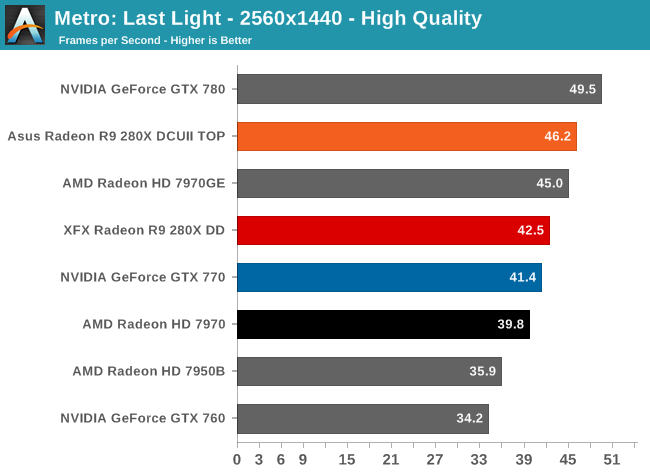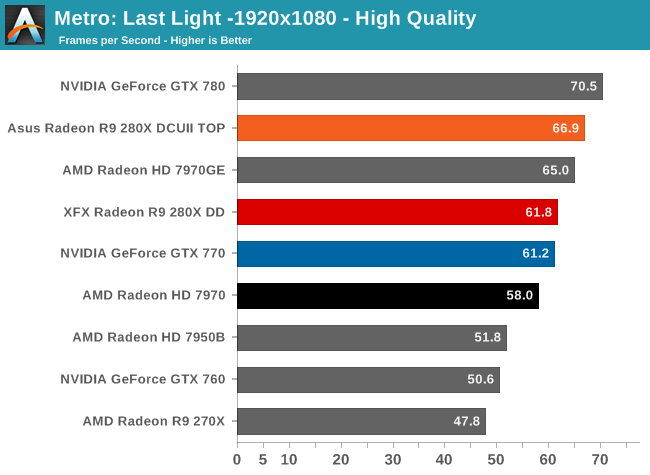The Radeon R9 280X Review: Feat. Asus & XFX - Meet The Radeon 200 Series
by Ryan Smith on October 8, 2013 12:01 AM ESTMetro: Last Light
Kicking off our look at performance is 4A Games’ latest entry in their Metro series of subterranean shooters, Metro: Last Light. The original Metro: 2033 was a graphically punishing game for its time and Metro: Last Light is in its own right too. On the other hand it scales well with resolution and quality settings, so it’s still playable on lower end hardware.



The first benchmark in our revised benchmark suite finds our 280X cards doing well for themselves, and surprisingly not all that far off from the final averages. Setting the baseline here, as we expected the Tahiti based 280X performs in between the original 7970 and 7970 GHz Edition, thanks to the 280X’s use of PowerTune Boost but at lower clockspeeds than the 7970GE. Consequently this isn’t performance we haven’t seen before, but it’s very much worth keeping in mind that the 7970GE was a $400 card while the 280X is a $300 card, so approaching the 7970GE for $100 less is something of a significant price cut for the performance.
As for the immediate competitive comparison, we’ll be paying particular attention to 2560x1440, which should be the sweet spot resolution for this card. At 2560 we can see that the reference clocked 280X doesn’t just hang with the $400 GTX 770 but actually manages to edge it out by just over a frame per second. As a preface we’re going to see these two cards go back and forth throughout our benchmarks, but to be able to directly compete with NVIDIA’s fastest GK104 card for $100 less is a significant accomplishment for AMD.
Finally, let’s quickly talk about the Asus 280X versus the XFX 280X. Asus winning comes as no great shock due to their factory overclock, but now we finally get to see the magnitude of the performance gains from that overclock. At 2560 we’re looking at just shy of a 9% performance gain, which is in excess of both the boost clock overclock and the memory overclock. The specific performance gains will of course depend in the game in question, but this means that the performance gains in at least one instance are being impacted by the base clock overclock, the larger of Asus’s factory overclocks.










151 Comments
View All Comments
Galidou - Saturday, October 12, 2013 - link
If he really has to whine about high end video card prices, he's new to this because many generations before, the top of the line was often sold for 800$. Anyway, if you simply run 1080p(which most of us does) you can be totally satisfied with a 150-300$ video card and two or three graphical options not maxed(you won't notice it unless you stop playing to just look at the graphics) which is quite different from older generations where you had to pay big bucks to run at higher resolution/graphical settings.I bought a 660ti for 300$ when it came out a year ago and I still run everything at very high/max settings in 1080p PERFECTLY. No reason to whine at all nowadays unless you're a kiddo that is new to the gaming industry and pc gaming gear.
Etern205 - Monday, October 14, 2013 - link
Many generations before top of the end graphic cards like ATi Radeon 9700 Pro, the best card of its time cost $300, and the 2nd best, ATi Radeon 9500 Pro cost just $200.High-end card is the past don't cost a arm and a leg, you can get one and still have enough to feed yourself for a week. Now they cost a arm and a leg, where you have to starve yourself for a month just to have enough to buy one.
hansmuff - Tuesday, July 14, 2015 - link
The Matrox MGA Millennium 4MB was $549 at launch and became a somewhat legendary performer in DOS VESA modes. That's 1995.bwat47 - Monday, December 9, 2013 - link
Yeah, a 280x was a steal for 299, excellent card.Anand Lal Shimpi - Tuesday, October 8, 2013 - link
We're working on it :) AMD gave Ryan very little time to go through four new cards, it's being added in real time here.Sunrise089 - Tuesday, October 8, 2013 - link
No disrespect Anand, but 'special relationship' with AMD notwithstanding, if they're asking you to have your article up at midnight for a launch but you can't even have product specs available by then I worry the advertising side of things is encroaching a bit into the editorial side.zanon - Tuesday, October 8, 2013 - link
Have to agree. I've always appreciated in the past that Anandtech would take the time to do reviews right, even if it very, very often meant that they'd come in days or more after the early rush. We've already got plenty of early rush stuff on the net that is of poor quality, please do not go that route. Just do a pipeline piece with early conclusions as you have before. You've got this going up across all twitter/rss/whatever feeds, everyone sees it and comes in, and it's a really poor showing.If AMD tells you to hit a certain launch window please kindly tell them to get stuffed or get your hardware earlier next time. If you're letting them rush you to their own schedule that feels like a really bad sign.
Anand Lal Shimpi - Tuesday, October 8, 2013 - link
See the above response, but I'd add: you don't have to worry about us going down the path of lowest common denominator. I hardly think that what was posted here at midnight was even close to fitting that description.Anand Lal Shimpi - Tuesday, October 8, 2013 - link
er below response :)chizow - Tuesday, October 8, 2013 - link
Easy guys, it's happened with other non-AMD reviews too in the past, I know other staff writers will often chip in and help with some aspects of the reviews, like tables and graphs, and sometimes the entire piece comes together online in real-time. It's like a big group project or presentation, sometimes it just doesn't go off perfectly on such short deadlines.